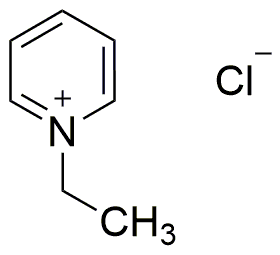1-Ethylpyridinium chloride is widely utilized in research focused on:
- Electrolytes in Energy Storage: This compound serves as a highly effective electrolyte in supercapacitors and batteries, enhancing energy efficiency and storage capacity.
- Solvent for Chemical Reactions: It acts as a solvent in various organic reactions, particularly in synthesizing pharmaceuticals and agrochemicals, due to its ability to dissolve a wide range of compounds.
- Biological Applications: Researchers use it in studies involving cell cultures and microbiology, as it can influence cellular processes and improve the solubility of certain biomolecules.
- Corrosion Inhibitors: In the field of materials science, it is employed as a corrosion inhibitor for metals, providing a protective layer that extends the lifespan of metal components.
- Electrochemical Sensors: This compound is utilized in the development of electrochemical sensors, offering high sensitivity and selectivity for detecting various analytes in environmental monitoring.
General Information
Properties
Safety and Regulations
Applications
1-Ethylpyridinium chloride is widely utilized in research focused on:
- Electrolytes in Energy Storage: This compound serves as a highly effective electrolyte in supercapacitors and batteries, enhancing energy efficiency and storage capacity.
- Solvent for Chemical Reactions: It acts as a solvent in various organic reactions, particularly in synthesizing pharmaceuticals and agrochemicals, due to its ability to dissolve a wide range of compounds.
- Biological Applications: Researchers use it in studies involving cell cultures and microbiology, as it can influence cellular processes and improve the solubility of certain biomolecules.
- Corrosion Inhibitors: In the field of materials science, it is employed as a corrosion inhibitor for metals, providing a protective layer that extends the lifespan of metal components.
- Electrochemical Sensors: This compound is utilized in the development of electrochemical sensors, offering high sensitivity and selectivity for detecting various analytes in environmental monitoring.
Documents
Safety Data Sheets (SDS)
The SDS provides comprehensive safety information on handling, storage, and disposal of the product.
Product Specification (PS)
The PS provides a comprehensive breakdown of the product’s properties, including chemical composition, physical state, purity, and storage requirements. It also details acceptable quality ranges and the product's intended applications.
Certificates of Analysis (COA)
Search for Certificates of Analysis (COA) by entering the products Lot Number. Lot and Batch Numbers can be found on a product’s label following the words ‘Lot’ or ‘Batch’.
*Catalog Number
*Lot Number
Certificates Of Origin (COO)
This COO confirms the country where the product was manufactured, and also details the materials and components used in it and whether it is derived from natural, synthetic, or other specific sources. This certificate may be required for customs, trade, and regulatory compliance.
*Catalog Number
*Lot Number
Safety Data Sheets (SDS)
The SDS provides comprehensive safety information on handling, storage, and disposal of the product.
DownloadProduct Specification (PS)
The PS provides a comprehensive breakdown of the product’s properties, including chemical composition, physical state, purity, and storage requirements. It also details acceptable quality ranges and the product's intended applications.
DownloadCertificates of Analysis (COA)
Search for Certificates of Analysis (COA) by entering the products Lot Number. Lot and Batch Numbers can be found on a product’s label following the words ‘Lot’ or ‘Batch’.
*Catalog Number
*Lot Number
Certificates Of Origin (COO)
This COO confirms the country where the product was manufactured, and also details the materials and components used in it and whether it is derived from natural, synthetic, or other specific sources. This certificate may be required for customs, trade, and regulatory compliance.


